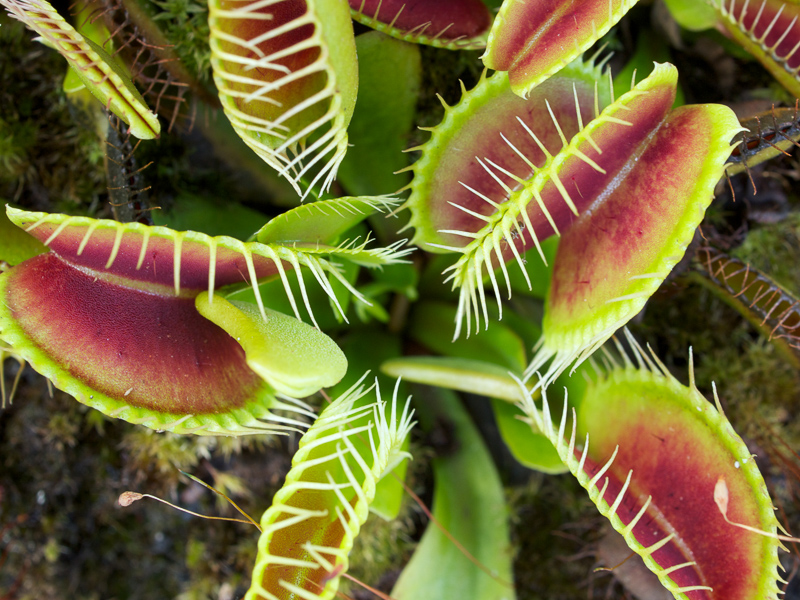Captivating Carnivores: The Venus Flytrap
For immediate release ‐ August 04, 2021
Contact: Micah Beasley, 919.707.9970. Images available upon request

By Amanda Rossillo, Whiteville intern
Wetlands are an essential component of southeastern North Carolina’s landscape. Swamps, lakes, and other wetland habitats provide important services to people and the natural world, from filtering pollutants and preventing floods to serving as homes for fish and wildlife. In this column, we’ll take deep dives into some of the fascinating wetland flora and fauna in southeastern North Carolina, starting with the Venus flytrap.
Though these carnivorous plants are world famous, they are only found naturally in a select few wetland habitats within a 100-mile radius of Wilmington, NC, within the homelands of the Waccamaw Siouan, Lumbee, Chicora, and Cape Fear peoples. They grow in wet, acidic soils, and while they can survive through photosynthesis alone, insects supply important missing nutrients and are a critical component of their diets.
Though they’re less than 10 centimeters tall, these plants pack a punch. They consist of a stem with several leaves that each terminate in jaw-like structures with large, sharp spikes. They also produce white flowers, which bloom in May and June and grow tall above the traps. This arrangement prevents the flytraps from accidentally eating the bees that pollinate it.
Although there are over 30 species of carnivorous plants in North Carolina, and at least 14 in Green Swamp on the edge of Columbus and Brunswick Counties alone, the Venus flytrap is unique in the way it captures prey. Like other carnivorous plants, it lures in prey using sweet-smelling nectar. But rather than trapping insects in sticky nectar like pitcher plants, or sucking in prey through a vacuum like bladderwort, Venus flytraps snap their traps shut when hair-like sensors on the trap’s inner surface are disturbed.
Plenty of non-insects trigger these sensors, though, like raindrops or dust. To prevent the plant from wasting energy shutting the trap when it’s empty, the sensors have evolved to require two separate disturbances in order to close. If a second disturbance signal isn’t received within about 20 seconds of the first, the trap won’t close. If it is, the trap will snap shut in less than 1/10th of a second—faster than the blink of an eye.
How does the Venus flytrap digest without a stomach? Once an insect has been captured, the spikes at the end of the jaws seal the trap shut. Then, the plant secretes chemicals that dissolve the insect. The plant extracts the nutrients, and after a few weeks the trap will open to await its next meal.
Although Venus flytraps are famous for consuming insects, especially spiders and ants, the average flytrap will only feed on them three to five times in its lifetime. After that, the plant relies only on photosynthesis for all of its energy. If a certain trap closes 10 times without successfully capturing prey, that leaf will stop responding to disturbances and will only be used for photosynthesis.
Fires in wetlands may seem counterproductive, but they are essential for Venus flytraps’ success. Wildfires used to occur regularly during the summers, and these plants evolved to withstand them. Because they grow close to the ground, flytraps eventually became dependent on fires to clear out taller competitors that had better access to sunlight. Today, natural wildfires in the Southeast are not as common as they once were. However, the modern use of controlled burns by environmental experts have allowed flytraps and other plants to survive in their increasingly threatened environments.
Despite the recent success of prescribed burns, Venus flytrap populations have declined dramatically over the last few decades. Habitat loss due to human encroachment, a century of intentional fire suppression and poaching have reduced flytrap populations by half since 1958. Venus flytrap poaching is now a felony in North Carolina.
The Venus flytrap is a source of pride for North Carolinians, especially Southeastern North Carolina residents, and tourists from around the world visit to see these unique plants. As such, great care must be taken to protect those remaining in the wild and their wetland habitats. Visit the NCMNS at Whiteville to see Venus flytraps up close. To view these plants in their native habitat, visit the Green Swamp Preserve, or Lake Waccamaw State Park to view flytraps respectfully. When purchasing a Venus flytrap, look for plants that are legally sourced from garden centers or plant nurseries. If you suspect poaching, visit ncwildlife.org/wildtip or call 1.855.WILDTIP to submit an anonymous tip. By taking these steps, we can help these vulnerable, fascinating local plants and wetland ecosystems persevere.
For more information about our upcoming activities, conservation news and ground-breaking research, follow @NaturalSciences on Instagram, Twitter and Facebook. Join the conversation with #visitNCMNS.

